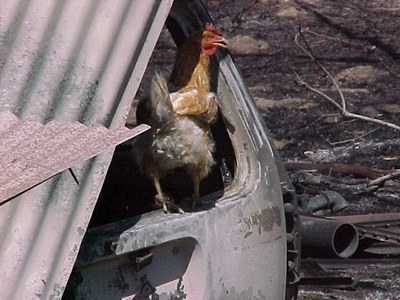Caring For Your Pets and Livestock After Wildfire
 In addition to affecting your health and safety, wildfire also poses a threat to pets and livestock. Unfortunately disasters can mean that animals are left behind. This section offers some resources and precautions related to pets and livestock. See our Immediate Safety section for general safety information.
In addition to affecting your health and safety, wildfire also poses a threat to pets and livestock. Unfortunately disasters can mean that animals are left behind. This section offers some resources and precautions related to pets and livestock. See our Immediate Safety section for general safety information.
Pets
-
The accepted sequence for safety and evacuation is people first, then pets, then livestock, and then property. The same can be said of disaster recovery.
-
First and foremost: Stay away from your home or business until fire officials tell you it is safe to return.
-
Make sure your pet has some kind of identification, ideally a collar with a tag that has your contact information on it. Microchips also help; make sure you have at least one non-local contact person listed on your pet's chip registration in case local phones are out.
-
Whenever possible, do not leave animals behind. They can be lost, injured or killed.
-
Human evacuation shelters generally do not allow pets except for service animals.
-
Pet evacuation shelters are often available. To find out more about the location of shelters and other services available to pet owners, call Animal Protection of New Mexico at 505-265-2322 Ext. 29.
Livestock
-
The health and safety of livestock is primarily the responsibility of the owner.
-
Evacuation centers for livestock are usually located at country fairgrounds. Call your county emergency manager or the livestock board to find out more about these facilities.
-
Adrenaline, panic and confusion affect both humans and animals, so be aware of these effects.
-
Use caution when working with livestock after a wildfire. Their survival instincts can make normal handling techniques ineffective. Livestock are very sensitive to wildfire and will respond to a fire that is anywhere within their sensory range. Normal reactions range from nervousness to panic to aggressive escape attempts.
-
Livestock are often injured or killed by fleeing from a wildfire into fences and barriers. Be sure to check your animals for injuries from fences and to check your fences for damage from fleeing animals.
-
Report location, identification and disposition of your livestock to the authorities responding to the fire, especially if your animals are aggressive.
-
After you have been allowed to return to your property, it is important to locate your livestock and ensure they have access to high-quality forage with a protein and mineral supplement and good water. If livestock do not get adequate nutrition, their condition can deteriorate rapidly.
-
Check surviving livestock for signs of injury. Health disorders such as burned eyes, burned areas, and lung inflammation and edema from smoke inhalation are common after livestock experience wildfire. Have your livestock inspected by a vet as soon as possible. It can take a while for symptoms to appear, so monitor your cattle for several weeks after the fire.
-
After wildfire, be sure your livestock are pastured somewhere safe from flash floods and post-fire flooding, if possible.
-
Livestock have a natural instinct to move away from flash flood waters, and will generally seek higher ground if they can. Livestock will initially panic during flash floods and will fight fences if they are impeding their movement away from floodwaters. Be sure your pasture is fenced in a way that maximizes access to high ground to minimize injury and death.
-
The New Mexico Livestock Board and its partners assist in evacuations and work to make sure any livestock that had to be evacuated during a fire are claimed by their owners.
-
In the event of livestock fatalities, contact the State Livestock Board at 505-841-6161 to find out about disposal methods.
-
For additional information on assistance offered by the Livestock Board, call 505-841-6161.
-
The State Veterinarian, Ellen Wilson, DVM, can be reached at 505-841-6161 or through email at Ellen.Wilson@state.nm.us.
